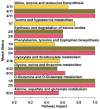Characterization of Yak Common Biofluids Metabolome by Means of Proton Nuclear Magnetic Resonance Spectroscopy
- PMID: 30832316
- PMCID: PMC6468419
- DOI: 10.3390/metabo9030041
Characterization of Yak Common Biofluids Metabolome by Means of Proton Nuclear Magnetic Resonance Spectroscopy
Abstract
The aim of this study was to evaluate the metabolic profiles of yak (Bos grunniens) serum, feces, and urine by using proton nuclear magnetic resonance (¹H-NMR), to serve as a reference guide for the healthy yak milieu. A total of 108 metabolites, giving information about diet, protein digestion, and energy generation or gut-microbial co-metabolism, were assigned across the three biological matrices. A core metabolome of 15 metabolites was ubiquitous across all biofluids. Lactate, acetate, and creatinine could be regarded as the most abundant metabolites in the metabolome of serum, feces, and urine, respectively. Metabolic pathway analysis showed that the molecules identified could be able to give thorough information about four main metabolic pathways, namely valine, leucine, and isoleucine biosynthesis; phenylalanine, tyrosine, and tryptophan biosynthesis; glutamine and glutamate metabolism; and taurine and hypotaurine metabolism.
Keywords: 1H-NMR; Bos grunniens; feces; metabolomics; serum; urine; yak.
Conflict of interest statement
The authors declare no conflict of interest.
Figures






Similar articles
-
Exploration of metabolite profiles in the biofluids of dairy cows by proton nuclear magnetic resonance analysis.PLoS One. 2021 Jan 29;16(1):e0246290. doi: 10.1371/journal.pone.0246290. eCollection 2021. PLoS One. 2021. PMID: 33513207 Free PMC article.
-
Metabolomics Comparison of Hanwoo (Bos taurus coreanae) Biofluids Using Proton Nuclear Magnetic Resonance Spectroscopy.Metabolites. 2020 Aug 14;10(8):333. doi: 10.3390/metabo10080333. Metabolites. 2020. PMID: 32824041 Free PMC article.
-
Dominant components of the Thoroughbred metabolome characterised by (1) H-nuclear magnetic resonance spectroscopy: A metabolite atlas of common biofluids.Equine Vet J. 2015 Nov;47(6):721-30. doi: 10.1111/evj.12333. Epub 2015 Jan 28. Equine Vet J. 2015. PMID: 25130591
-
An Untargeted Metabolomics Investigation of Jiulong Yak (Bos grunniens) Meat by 1H-NMR.Foods. 2020 Apr 12;9(4):481. doi: 10.3390/foods9040481. Foods. 2020. PMID: 32290528 Free PMC article.
-
First Steps toward the Giant Panda Metabolome Database: Untargeted Metabolomics of Feces, Urine, Serum, and Saliva by 1H NMR.J Proteome Res. 2020 Mar 6;19(3):1052-1059. doi: 10.1021/acs.jproteome.9b00564. Epub 2020 Feb 7. J Proteome Res. 2020. PMID: 31994893
Cited by
-
Multi-omics analyses reveal rumen microbes and secondary metabolites that are unique to livestock species.mSystems. 2024 Feb 20;9(2):e0122823. doi: 10.1128/msystems.01228-23. Epub 2024 Jan 31. mSystems. 2024. PMID: 38294243 Free PMC article.
-
Comparative untargeted metabolome analysis of ruminal fluid and feces of Nelore steers (Bos indicus).Sci Rep. 2021 Jun 17;11(1):12752. doi: 10.1038/s41598-021-92179-y. Sci Rep. 2021. PMID: 34140582 Free PMC article.
-
Exploration of metabolite profiles in the biofluids of dairy cows by proton nuclear magnetic resonance analysis.PLoS One. 2021 Jan 29;16(1):e0246290. doi: 10.1371/journal.pone.0246290. eCollection 2021. PLoS One. 2021. PMID: 33513207 Free PMC article.
-
Special Issue on "NMR-Based Metabolomics and Its Applications Volume 2".Metabolites. 2020 Jan 26;10(2):45. doi: 10.3390/metabo10020045. Metabolites. 2020. PMID: 31991891 Free PMC article.
-
1H nuclear magnetic resonance-based metabolomics study of serum and pectoralis major for different commercial chicken breeds.Food Sci Nutr. 2023 Apr 7;11(5):2106-2117. doi: 10.1002/fsn3.2968. eCollection 2023 May. Food Sci Nutr. 2023. PMID: 37181311 Free PMC article.
References
LinkOut - more resources
Full Text Sources
Molecular Biology Databases

